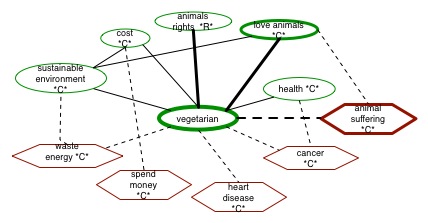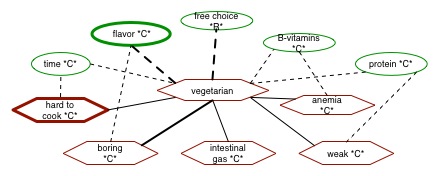PHIL 226, Exercise 3, Value Map 3
Note: key differences from exercise 2 are indicated in red.
Introduction
This assignment is due Thursday, Nov. 22 in class. It is worth 8 marks out of 100 for the course.
Late assignments will be accepted until Nov. 27, in class, but will lose 2 marks.
After Nov. 27at 8:30, assignments will not be accepted, except for documented reasons of illlness or family emergency.
Instructions
Students will analyze an important issue in biomedical ethics using value maps, a kind of cognitive-affective map.
Choose ONE of the two topics below.
Hand in a single page, two-sided, consisting of:
- Your last name, first name, student number.
- Title: topic question.
- Value map of the yes view.
- Value map of the no view.
- Discussion, 150-200 words, of the similarities and differences between the yes and no views. Provide a word count.
- Conclusion, 50-100 words, on why you think the yes map or the no map is ethically superior.
If you have to hand in more than one page, staple the pages together, or lose 1 mark.
Topics
1. Should grade 8 girls in Ontario be given the HPV vaccine? Yes or no.
2. Should doctors prescribe stimulant drugs such as Adderall to normal students to improve their academic performance? Yes or no.
3. Should it be mandatory that people in healthcare (doctors, nurses, paramedics) have influenza vaccinations? Yes or no.
Drawing Value Maps
Instructions for drawing cognitive-affective maps are available here.
Each map (maximum 1/2 page) must include:
- A node for the topic, e.g INJECTION SITES, ELECTRONIC RECORDS. This will be positive in the yes map and negative in the no map. Do not include an opposite of this node.
- At least 5 positive concepts, represented by ovals.
- At least 5 negative concepts, represented by hexagons.
- Marker of *C* for consequences or *R* for rights for all positive and negative concepts.
- At least one concept marked *C* and at least one marked *R*.
- At least 3 positive support links between concepts, represented by straight lines.
- At least 2 negative conflict links between concepts, represented by dotted lines.
- Green circles and red hexagons, if you use colour (optional).
- Support for a positive concept (oval) by complimenting it (solid line) with other positive elements.
- Support for a positive concept (oval) by having it conflict (dotted line) with a negative concept (hexagon).
- Counter-support against negative elements (hexagon) by solid lines to other negative elements or dotted lines to positive elements.
- Indicate at least one very important support and one very important conflict by using THICK lines. Do not use all thick lines.
- Indicate at least two nodes as very important by making the oval or hexagon thick. Do not use all thick lines.
Tools for drawing value maps.
- EMPATHICA will be the easiest for many students. Known bugs: does not work with some laptops. Do not use the Google ap version.
- Any computer drawing program, e.g. Microsoft Office, OpenOffice, OmniGraffle, Illustrator, etc.
- Hand drawing - a stencil will help.
DO NOT:
- Have any nodes that include the following words: for, against, pro, con, right, wrong, no, non, morally.
- Confuse emotionally positive and negative concepts, or complimentary and conflicting links.
- Have the same node both positive and negative (ambivalent).
- Have nodes that are completely unconnected to other nodes.
- Have connections that don't make sense, e.g. having LOVE OF ANIMALS linked supportively with ANIMAL SUFFERING.
- Present both the pro and con side in the same map.
Marking
Each value map will be worth 3 marks.
The discussion will be worth 1 mark, and the conclusion 1 mark.
Example
1. Pro-vegetarian value map

2. Anti-vegetarian value map

Paul
Thagard
Computational Epistemology
Laboratory.
This page updated Nov. 12, 2012


